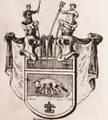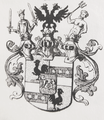Hype (noble family)

The Rummel (sometimes also written Rumel , Rumbl or Rumell ) are a noble family who had settled in Nuremberg since 1303 and had long-distance trade there since 1370. Later she also acquired properties in the Upper Palatinate and Austria .
history
For the first time in 1281, a Cunradus Rummel was named as a source of income for the Cistercian monastery Heilsbronn . A Seitz hype from Ottensoos is also given in 1360 .
Heinrich Rummel from Wollersdorf , who was naturalized in Nuremberg in 1303, is considered to be the progenitor of the family . These rummels had been active in long-distance trade since 1370, their trading area extended over all of Central Europe.
In addition to money transactions (including in Venice, Bologna, Florence, Milan, Rome and Lübeck), they preferred to trade in spices, cloths, silk goods, furs, precious metals (especially silver) and saltpetre. From 1412 they had their own chamber in the Fondaco dei Tedeschi in Venice , which was passed on to a Cologne merchant in 1497. Henry III. († 1476) and Wilhelm IV. Expanded the field of activity around 1460 by entering the mining business. Sebald I († 1483), a grandson of Heinrich I , founded a branch of the family in Schwaz or in Rattenberg , which was still active in silver and copper mining in the 16th century. His son Peter , who called himself Peter Rummel von Lichtenau († 1519), was included in the Tyrolean nobility register in 1511.
He had been a caretaker in Sigmundslust Castle from 1497 and rose to the position of councilor and house treasurer of Archduke Sigismund and the council of Emperor Maximilian . In 1500 he became the owner of Sigmundslust Castle. He also had the castle renewed before 1500. In 1520 it is to the Schwaz trades Jörg Stöckl sold. Anton Rummel von Lichtenau († 1538), Peters brother , administered the princely hut in Rattenberg and in 1512 became the keeper of the Schwaz regional court. With his grandson Anton , the caretaker of Bruneck , the Tyrolean branch of the Rummels died out in 1590.
Henry I. Rummel (* 1340, † 1417), probably a grandson of the ancestor, acquired in 1409 by the Council of the City of Nuremberg rule Lichtenau , 1410 received from King Ruprecht the blood spell . Heinrich I , known as the Rich , withdrew from long-distance trade in 1401 and joined the Inner Council of the Imperial City of Nuremberg in 1402. His son, the knight Franz von Rummel, sold the Lichtenau estate to the Nuremberg alms office in 1472.
The sons and grandsons of Heinrich I. Rummel were married to women from the Nuremberg patriciate. These were Heinrich II. († 1446), Hans I. († 1434) and Franz I († 1460), who followed in 1426, 1427 and 1428 as mayor. Hans Rummel , a citizen of Nuremberg, bought the Lonnerstadt castle stable from Hans von Vestenberg in 1403 and the Rummel von Lonnerstadt possessions in 1414 . Franz I accompanied King Sigismund in 1433 to his coronation as emperor in Rome, where he was knighted. In 1435 he made a pilgrimage to the Holy Land with Margrave Albrecht Achilles and his brother Johann. In the First Margrave War , Franz I was one of the Nuremberg commanders. His nephew Ulrich († 1463), margrave caretaker of Roth, fought on the margravial side . The daughter of Wilhelm IV. Anna († 1521), married Hans Frey in 1472 , her daughter Agnes (* 1475; † 1539) married Albrecht Dürer in 1494 .
Wilhelm VII. Rummel (* 1540; † 1591) was still a member of the Inner Council of Nuremberg from 1571 to 1575, his brother Balthasar II. (* 1547; † 1620) had been Nuremberg nurse at Hohenstein from 1612 and Nuremberg nurse at Betzenstein from 1613 , after 1576 both bought the Hofmark Zant . Conrad Thomas Rummel von Lichtenau zu Zandt married Maria Anna Violanda von Salis in 1677 and received the Hofmark Zell (formerly Lobenstein ) through her ; the Rummel family remained in possession of this Hofmark until 1803. His son, Johann Ludwig von Rummel (born November 27, 1696; † March 18, 1761 in Amberg ), married Maria Anna Christiana Nothphia von Weissenstein in 1717 ; he was on September 22, 1761 by Elector Maximilian III. Joseph raised to the baron status. The couple had four children: Johann Wilhelm (* August 25, 1729), Maria Franziska Carolina (* February 26, 1733), Maria Josepha Walburga (* January 17, 1740) and Joseph Anton (* June 25, 1743).
Known archbishop's diocese of Vienna, Franz Ferdinand von Rummel (born 28 October 1644 in Weiden , † March 15, 1716 in Vienna ) of the future emperor, the educator Joseph I was. He acquired the lords of Gars and Buchberg am Kamp . These possessions then went to his nephew, the Unterjägermeister Franz Joseph . One of his brothers is the churbayer grenadier captain Wilhelm Ludwig Romedi Freiherr von Rummel , whose wife was a born Reichsfreiin von Gise . Colonel Joseph Freiherrn von Rummel is the progenitor of the Freiherren Rummel zu Pfrentschen and Herrenried . In 1702 Wilhelm Ludwig von Rumel acquired three quarters of Herrnried Castle and in 1708 he bought the rest. Herrried remained in the possession of the Rummels until the 19th century. The later Gustav Adolph Imperial Baron von Rummel was a staff officer in the cavalry in Bavarian military service. Baron Gustav von Rummel then sold the property to Baron Karl von Mengershausen in 1856 .
A branch of the family came into the possession of Waldau . The first was Franz Ferdinand von Rummel in 1681 . His son, Johann Karl Freiherr von Rummel , married to Rosina Dorothea, b. In 1716 Freiin von Podewils donated a benefit to Waldau; he also had the dilapidated Waldau church relocated to Waldau Castle, which was already empty . His son Joseph Freiherr Rummel von Waldau (* 1714 in Waldau; † June 14, 1789 in Vienna) became an Imperial and Royal Colonel and Knight of the Maria Theresa Order . A Johann Nepomuk Freiherr von Rummel zu Waldau (* 1744, † 1795) was a page, court councilor, chamber councilor and clergyman and member of the Illuminati order . The over-indebted possessions of Waldau came to the Barons of Lilien in 1810 .
From 1702 to 1711 Konrad Thomas Rummel is recorded at Winbuch Castle .
From 1726 Franziska von Rummel was the owner of Engelseck Castle . In 1783 Baroness Franziska von Rummel sold the property to Jakob Voith .
The church Öden hard castle is from 1756 in the possession of some Sisters of hype, 1792 will here widow Anna Hildegard of Fachbach, born by Rummel , called. Elisabeth von Rummel († 1821, buried in Dietldorf ) last lived here . She was married to the then mayor of Regensburg, Gottlieb Carl Freiherr von Thon-Dittmer , who came into the possession of the Kirchenödenhart rulership by marriage.
The Emhof Palace was owned by the Barons von Rummel from 1769 to 1800.
Current descendants of this family, such as the archaeologist Philipp von Rummel , still exist today.
coat of arms
The brothers Franciscus , Johannes , Heinrich , Georius and Wilhelm received from Emperor Siegmund in Rome on the Friday before Margarethen 1433 the confirmation and improvement of their coat of arms ( decoratio coronae ). The brothers Wolfgang and Christoph Rumel received the same pardon on February 14, 1539. This coat of arms is described as follows: “upright next to each other two Hanen with open beaks, the kerende and r. knocked out Zunglin, Kamp and Lappen ”, from the helmet a growing rooster with wings, in 1751 they lead a rooster between two wings with wings on the helmet.
The hustle and bustle of Lichtenau and Lonerstadt had two averted cocks in the coat of arms, on the helmet a large growing cock with wings, later (after 1751) on the helmet a cock with wings with large wings. The Rummel coat of arms from the 17th century now shows a Neptune on one of the helmets and is a combination of the three older coats of arms.
When it was raised to the baron status, the coat of arms was changed beyond recognition. Now it is quartered with a heart sign, on it stands a wolf in red on a green lawn, suckling two naked boys. This well-known picture of Romulus and Remus is probably an allusion to the name Rummel. In the 1st and 4th quadrants of the main shield there is a battle-armored rooster looking outward on a large mountain, in the 2nd and 3rd quadrant there is a blue bar with three gold stars. Of the three helmets, the first wears a crowned and armored man growing out of it, who holds a sword in each hand, the second a crowned black double-headed eagle, the third a growing sea god (Neptune). This coat of arms was used by the rummels in the Upper Palatinate.
- Coat of arms variants
Famous family members
- Franz Ferdinand von Rummel (1644–1716), Prince-Bishop of the Diocese of Vienna
- Gustav Waldau , actually Gustav Theodor Clemens Robert Freiherr von Rummel (born February 27, 1871 at Piflas Castle , Ergolding , † May 25, 1958 in Munich) was a German theater and film actor. The Waldaugasse in Vienna Grinzing was named in his honor in 1960 , as well as Gustl-Waldau-Strasse in Planegg and Ergolding.
- Walter von Rummel (1873–1953), German writer
- Friedrich von Rummel (1910–2002), German diplomat
- Philipp von Rummel (born April 30, 1975), German archaeologist
literature
- Otto Titan von Hefner ; Gustav Adelbert Seyler : The coat of arms of the Bavarian nobility. Repro. J. Siebmacher's large book of arms . II. Volume. Nuremberg 1856 Volume 22, Dead Bavarian families. Bauer & Raspe, Neustadt an der Aisch, 1971. ISBN 3-87947-022-7 .
- Friedrich von Rummel : Franz Ferdinand von Rummel: teacher of Emperor Joseph I and Prince-Bishop of Vienna (1644-1716). Oldenbourg, Munich 1980.
- Walther Ziersch: Gustav Waldau (actually Gustav Theodor Clemens Robert Freiherr von Rummel). An artist life of our time. Zinnen-Verlag, Munich 1942.
Web links
- Constantin von Wurzbach : Rummel, the barons of . In: Biographisches Lexikon des Kaiserthums Oesterreich . 27th part. Kaiserlich-Königliche Hof- und Staatsdruckerei, Vienna 1874, p. 258 ( digitized version ).
- Constantin von Wurzbach : Rummel von Waldau, Joseph Freiherr . In: Biographisches Lexikon des Kaiserthums Oesterreich . 27th part. Kaiserlich-Königliche Hof- und Staatsdruckerei, Vienna 1874, p. 257 ( digitized version ).
- Weißensteiner, Johann, "Rummel, Franz Ferdinand Freiherr von" in: Neue Deutsche Biographie 22 (2005), pp. 248–249
- Diefenbacher, Michael, "Rummel" in: Neue Deutsche Biographie 22 (2005), pp. 246–248
Individual evidence
- ↑ Biography of the hype of Zant and Lonnerstadt
- ↑ Constantin von Wurzbach : Rummel, the barons of . In: Biographisches Lexikon des Kaiserthums Oesterreich . 27th part. Kaiserlich-Königliche Hof- und Staatsdruckerei, Vienna 1874, p. 258 ( digitized version ).
- ↑ From Bishop Otto to Gustav Waldau: The street names in the large community of Vohenstrauss. A piece of local history. Onetz from June 6, 2012
- ↑ Gustav Waldau on imdb.com









